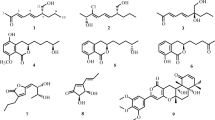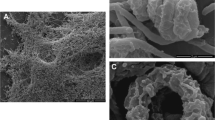Abstract
Two strains of endophytic fungi, Penicillium melinii Yuan-25 and Penicillium janthinellum Yuan-27, with strong anti-Pyricularia oryzae activity, were obtained from the roots of Panax ginseng. Based on bioactivity-oriented isolation, a new benzaldehyde derivative, ginsenocin (1), together with six known compounds, methyl 2,4-dihydroxy-3,5,6-trimethylbenzoate (2), 3,4,5-trimethyl-1,2-benzenediol (3), penicillic acid (4), mannitol (5), ergosterol (6), and ergosterol peroxide (7), were separated from the EtOAc extract of Yuan-25 culture, while brefeldin A (8) was isolated as the major constituent from the EtOAc extract of Yuan-27 culture. The chemical structures were determined based on spectroscopic methods. All the isolated compounds 1–8 were evaluated for their cytotoxicity against six human cancer cell lines. Brefeldin A (8) was the most cytotoxic constituent against all the tested cell lines with IC50 values <0.12 μg/ml, while ginsenocin (1) and penicillic acid (4) also exhibited potent cytotoxicity with IC50 values ranging from 0.49 to 7.46 μg/ml. Our results suggest that endophytic fungi isolated from P. ginseng are a promising natural source of potential anticancer agents.





Similar content being viewed by others
References
Aly AH, Debbab A, Kjer J, Proksch P (2010) Fungal endophytes from higher plants: a prolific source of phytochemicals and other bioactive natural products. Fungal Diversity 41(1):1–16
Ciegler A, Detroy RW, Lillehoj EB (1971) Microbial toxins (chapter 6): patulin, penicillic acid, and other carcinogenic lactones. Academic, New York, p 417
Coon JT, Ernst E (2002) Panax ginseng: a systematic review of adverse effects and drug interactions. Drug Saf 25(5):323–244
Cui HB, Mei WL, Han Z, Wu J, Lin HP, Hong K, Dai HF (2008) Antibacterial metabolites from the fermentation broth of marine fungus 095407. Chin J Med Chem 18:131–134
Ernst E (2010) Panax ginseng: an overview of the clinical evidence. J Ginseng Res 34(4):259–263
Gunatilaka AAL (2006) Natural products from plant-associated microorganisms: distribution, structural diversity, bioactivity, and implications of their occurrence. J Nat Prod 69(3):509–526
Gunji S, Arima K, Beppu T (1983) Screening of antifungal antibiotics according to activities inducing morphological abnormalities. Agric Biol Chem 47(9):2061–2069
Guo H, O'Doherty GA (2008) De novo asymmetric synthesis of anthrax tetrasaccharide and related tetrasaccharide. J Org Chem 73(14):5211–5220
Guo LD, Huang GR, Wang Y, He WH, Zheng WH, Hyde KD (2003) Molecular identification of white morphotype strains of endophytic fungi from Pinus tabulaeformis. Mycol Res 107(Pt 6):680–688
Haerri E (1963) A fungal metabolite which is a macrocyclic lactone exhibiting a wide range of antibiotic activity produced by Penicillium brefeldianum Dodge. Helv Chim Acta 46:1235
Han Z, Mei WL, Cui HB, Zeng YB, Lin HP, Hong K, Dai HF (2008) Antibacterial constituents from the endophytic fungus Penicillium sp. of mangrove plant Cerbera manghas. Acta Chim Sinica 29:749–752
Han Z, Mei WL, Zhao YX, Deng YY, Dai HF (2009) A new cytotoxic isocoumarin from endophytic fungus Penicillium sp. 091402 of the mangrove plant Bruguiera sexangula. Chem Nat Comp 45:805–807
Hendriksen HV, Mathiasen TE, Adler-Nissen J, Frisvad JC, Emborg C (1988) Production of mannitol by Penicillium strains. J Chem Technol Bitechnol 43(3):223–228
Higgins KL, Arnold AE, Miadlikowska J, Sarvate SD, Lutzoni F (2007) Phylogenetic relationships, host affinity, and geographic structure of boreal and arctic endophytes from three major plant lineages. Mol Phylogenet Evol 42(2):543–555
Jasinghe VJ, Perera CO, Barlow PJ (2005) Bioavailability of vitamin D2 from irradiated mushrooms: an in vivo study. Brit J Nutr 93(6):951–956
Kamoldinov KS, Eshbakova KA, Bobakulov KM, Abdullaev ND (2011) Components of Fraxinus raibocarpa. Chem Nat Comp 47(3):448–449
Kim HL, Kochevar J (1995) Isolation of brefeldin A. Gen Pharmacol 26(2):363–364
Kimura Y, Nakahara S, Fujioka S (1996) Aspyrone, a nematicidal compound isolated from the fungus, Aspergillus melleus. Biosci Biotechnol Biochem 60:1375–1376
Klausner RD, Donaldson JG, Lippincott-Schwartz J (1992) Brefeldin A: insights into the control of membrane traffic and organelle structure. J Cell Biol 116(5):1071–1080
Kuo LM, Chen KY, Hwang SY, Chen JL, Liu YY, Liaw CC, Ye PH, Chou CJ, Shen CC, Kuo YH (2005) DNA topoisomerase I inhibitor, ergosterol peroxide from Penicillium oxalicum. Planta Med 71(1):77–79
Kuo CF, Hsieh CH, Lin WY (2011) Proteomic response of LAP-activated RAW 264.7 macrophages to the anti-inflammatory property of fungal ergosterol. Food Chem 126(1):207–212
Kwon HC, Zee SD, Cho SY, Choi SU, Lee KR (2002) Cytotoxic ergosterols from Paecilomyces sp. J300. Arch Pharm Res 25(6):851–855
Li C, Cai J, Geng J, Li Y, Wang Z, Li R (2012a) Purification, characterization and anticancer activity of a polysaccharide from Panax ginseng. Int J Biol Macromol 51(5):968–973
Li JT, Chen QQ, Zeng Y, Wang Q, Zhao PJ (2012b) A new phenol compound from endophytic Phomopsis sp. DC01. Nat Prod Res 26:2008–2012
Park JD, Rhee DK, Lee YH (2005) Biological activities and chemistry of saponins from Panax ginseng. Phytochem Rev 4:159–175
Qi LW, Wang CZ, Yuan CS (2011) Ginsenosides from American ginseng: chemical and pharmacological diversity. Phytochemistry 72(8):689–699
Rodriguez RJ, White JF Jr, Arnold AE, Redman RS (2009) Fungal endophytes: diversity and functional roles. New Phytol 182(2):314–330
Saitou N, Nei M (1987) The neighbor-joining method: a new method for reconstructing phylogenetic trees. Mol Biol Evol 4(4):406–425
Sausville EA, Duncan KL, Senderowicz A, Plowman J, Randazzo PA, Kahn R, Malspeis L, Grever MR (1996) Antiproliferative effect in vitro and antitumor activity in vivo of brefeldin A. Cancer J Sci Am 2(1):52–58
Saw CLL, Wu Q, Kong ANT (2010) Anti-cancer and potential chemopreventive actions of ginseng by activating Nrf2 (NFE2L2) anti-oxidative stress/anti-inflammatory pathways. Chin Med 5:37–43
Schulz B, Boyle C, Draeger S, AK R m, Krohn K (2002) Endophytic fungi: a source of novel biologically active secondary metabolites. Mycol Res 106(9):996–1004
Shawkat H, Westwood MM, Mortimer A (2012) Mannitol: a review of its clinical uses. Contin Educ Anaesth Crit Care Pain 12(2):82–85
Shin HR, Kim JY, Yun TK, Morgan G, Vainio H (2000) The cancer-preventive potential of Panax ginseng: a review of human and experimental evidence. Cancer Causes Control 11(6):565–576
Soman AG, Gloer JB, Wicklow DT (1999) Antifungal and antibacterial metabolites from a sclerotium-colonizing isolate of Mortierella vinacea. J Nat Prod 62:386–388
Stierle A, Strobel G, Stierle D (1993) Taxol and taxane production by Taxomyces andreanae, an endophytic fungus of Pacific yew. Science 260(5105):214–216
Strobel GA (2003) Endophytes as sources of bioactive products. Microbes Infect 5:535–544
Sun PX, Zheng CJ, Li WC, Jin GL, Huang F, Qin LP (2011) Trichodermanin A, a novel diterpenoid from endophytic fungus culture. J Nat Med 65:381–384
Suzuki S, Kimura T, Saito F, Ando K (1971) Antitumor and antiviral properties of penicillic acid. Agr Biol Chem 35(2):287–290
Thompson JD, Gibson TJ, Plewniak F, Jeanmougin F, Higgins DG (1997) The CLUSTAL_X windows interface: flexible strategies for multiple sequence alignment aided by quality analysis tools. Nucleic Acids Res 25(24):4876–4882
Wang FW (2012) Bioactive metabolites from Guignardia sp., an endophytic fungus residing in Undaria pinnatifida. Chin J Nat Med 10:72–76
Wang JF, Huang YJ, Fang MJ, Zhang YJ, Zheng ZH, Zhao YF, Su WJ (2002) Brefeldin A, a cytotoxin produced by Paecilomyces sp. and Aspergillus clavatus isolated from Taxus mairei and Torreya grandis. FEMS Immunol Med Microbiol 34:51–57
Wang J, Wu J, Huang W, Tan R (2006) Laccase production by Monotospora sp., an endophytic fungus in Cynodon dactylon. Bioresour Technol 97(5):786–789
Wang LW, Xu BG, Wang JY, Su ZZ, Lin FC, Zhang CL, Kubicek CP (2012) Bioactive metabolites from Phoma species, an endophytic fungus from the Chinese medicinal plant Arisaema erubescens. Appl Microbiol Biotechnol 93(3):1231–1239
Wu LS, Hu CL, Han T, Zheng CJ, Ma XQ, Rahmand K, Qin LP (2012) Cytotoxic metabolites from Perenniporia tephropora, an endophytic fungus from Taxus chinensis var. mairei. Appl Microbiol Biotechnol 97:305–315. doi:10.1007/s00253-012-4189-7
Xu LL, Han T, Wu JZ, Zhang QY, Zhang H, Huang BK, Rahman K, Qin LP (2009) Comparative research of chemical constituents, antifungal and antitumor properties of ether extracts of Panax ginseng and its endophytic fungus. Phytomedicine 16(6):609–616
Yu HS, Zhang L, Li L, Zheng CJ, Guo L, Li WC, Sun PX, Qin LP (2010) Recent developments and future prospects of antimicrobial metabolites produced by endophytes. Microbiol Res 165:437–449
Zhao J, Shan T, Mou Y, Zhou L (2011) Plant-derived bioactive compounds produced by endophytic fungi. Mini-Rev Med Chem 11(2):159–168
Zheng CJ, Li L, Han T, Qin LP (2012) Identification of a quinazoline alkaloid produced by Penicillium vinaceum, an endophytic fungus from Crocus sativus. Pharm Biol 50(2):129–133
Author information
Authors and Affiliations
Corresponding authors
Additional information
Cheng-Jian Zheng and Li-Li Xu contributed equally to this work.
Rights and permissions
About this article
Cite this article
Zheng, CJ., Xu, LL., Li, YY. et al. Cytotoxic metabolites from the cultures of endophytic fungi from Panax ginseng . Appl Microbiol Biotechnol 97, 7617–7625 (2013). https://doi.org/10.1007/s00253-013-5015-6
Received:
Revised:
Accepted:
Published:
Issue Date:
DOI: https://doi.org/10.1007/s00253-013-5015-6




